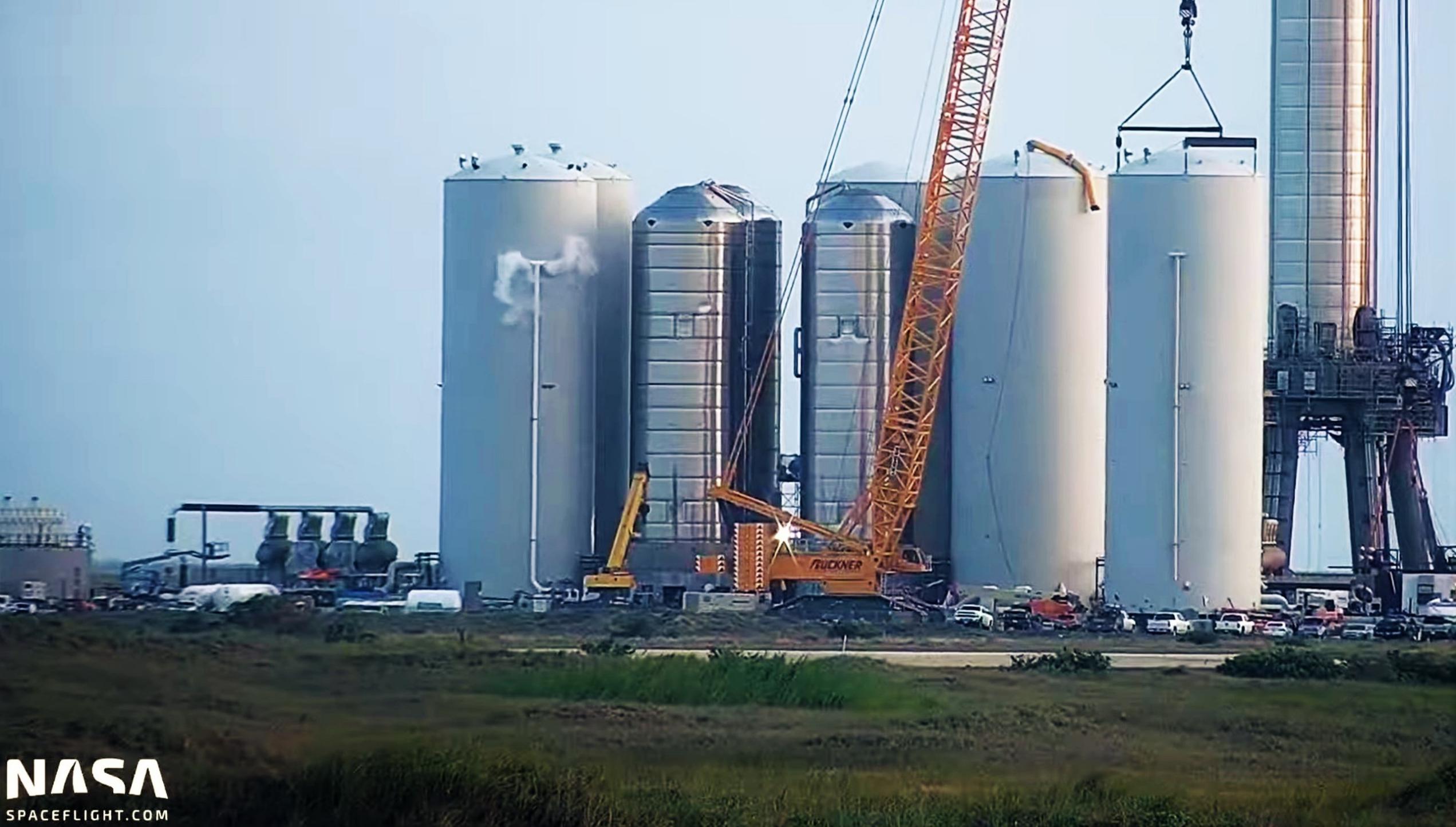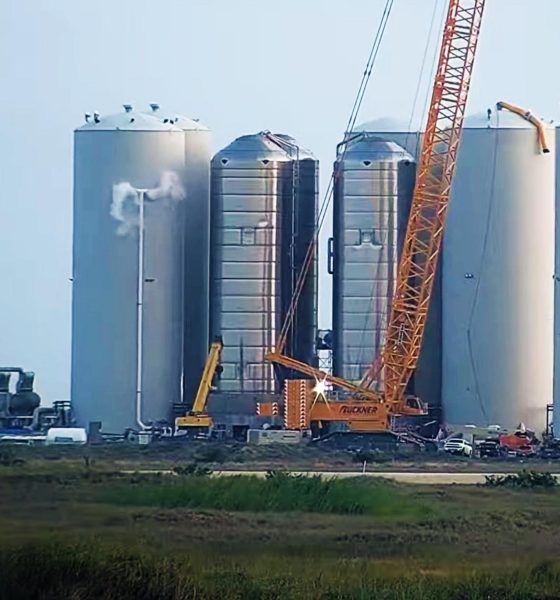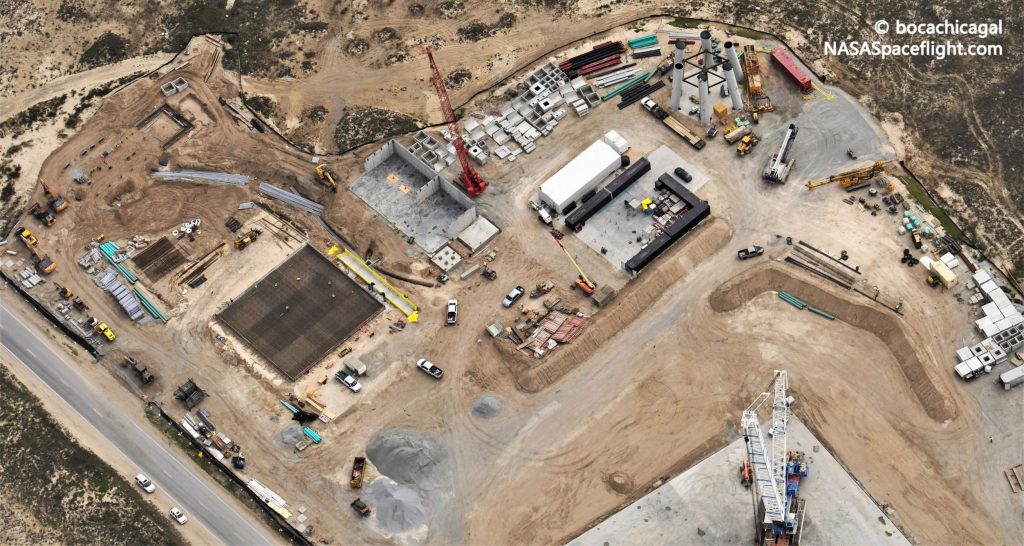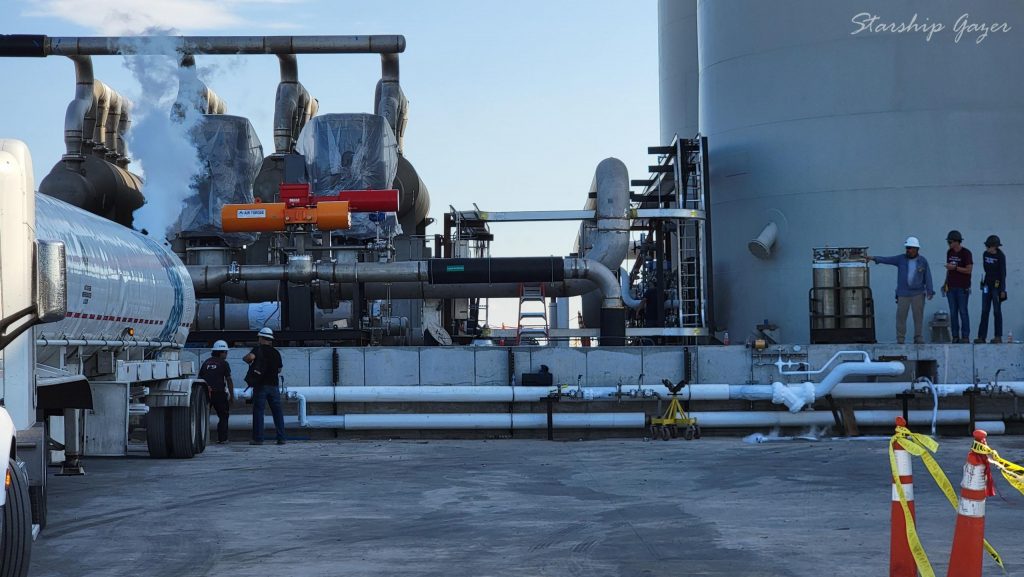

News
SpaceX’s orbital Starship launch pad tank farm comes to life for the first time
Update: Two days after a bevy of tanker trucks began to arrive at SpaceX’s orbital Starship launch site with load upon load of cryogenic liquid nitrogen, the company’s custom-built tank farm appears to have taken its very first ‘breaths.’
In other words, at least one of seven massive propellant storage tanks – two of which appear to have been fully completed and insulated – began venting. For a tank like SpaceX’s ground support equipment (GSE) tanks, the level of venting observed can only mean one thing: pressure maintenance during operations with cryogenic fluids. As cryofluids are loaded into empty tanks, they inevitably come into contact with warm pipes and tank walls, rapidly warming a portion of the liquid that then boils into gas. Tanks then need to vent that excess gas to avoid bursting.
In the case of SpaceX’s two completed liquid oxygen GSE tanks and a spate of liquid nitrogen (LN2) deliveries this week, it’s clear that the company has begun the process of testing and activating part of its brand new orbital-class Starship tank farm – beginning with much less risky LN2 proof testing. Filling the two finished LOx tanks with LN2 should also serve the dual purpose of flushing and cleaning them of any debris or contaminants, ensuring that it’s safe to fill them with LOx when the time comes.
For the first time, SpaceX appears to have begun delivering large quantities of cryogenic fluids to Starship’s orbital launch pad – still under construction but fast approaching some level of initial operational capability.
Sometime in the morning on September 19th, a semi-truck carrying a cryogenic liquid nitrogen (LN2) transport trailer arrived at SpaceX’s Starbase launch facilities. Normally, that would be a completely mundane, uninteresting event: SpaceX has used and will continue to use liquid nitrogen to safely proof test Starship prototypes and supercool their liquid methane (LCH4) and oxygen (LOx) propellant for the indefinite future. However, up to now, 100% of all Starbase cryogen deliveries have gone to the suborbital launch site, where two “mounts” and a few concrete aprons have supported all Starship and Super Heavy tests and launches to date.
Instead, this particular LN2 tanker headed for Starbase’s first orbital tank farm and began to offload its cryogenic liquid cargo at a number of brand new fill stations specifically designed for the task.
Still well under construction and at least a few weeks or months from total complete, Starship’s orbital launch site tank farm will ultimately be a group of eight massive storage tanks surrounded by thousands of feet of insulated plumbing, industrial pumps, a small army of “cryocoolers,” a blockhouse filled with human-sized valves, and much more. Said tank farm has been under construction for the better part of 2021, beginning with work on its concrete foundation this January.
Nine months later, the orbital tank farm is nearly complete. A power distribution and communications blockhouse has been complete for weeks with virtually all the wiring and cabling needed for the orbital launch mount and tower already in place. Several hundred feet of concrete cable and plumbing conduit have been filled with thousands of feet of wires, cables, and pipes and been sealed and buried. The tank farm blockhouse – where a dozen or so massive valves control the flow of propellant to and from the orbital launch mount and tower – is complete save for some final plumbing.

Finally, seven of eight GSE (ground support equipment) tanks have been installed and partially plumbed. Built in the same factory, six are virtually identical to Starship and Super Heavy tanks and will store LOx (3x), LN2 (2x), LCH4 (2x), and around a million gallons of water. Save for one LCH4 tank, all have been installed at the farm and that last tank (known as GSE8) is nearly complete back at the build site. Additionally, to insulate those seven thin, steel storage tanks, SpaceX has contracted with a water/storage tank company to build seven “cryoshells” and said million-gallon water tank.
The water tank was installed months ago and all seven shells are completed and ready to go as of last month. Only two of those seven cryoshells have been installed – and, rather asymmetrically, both on LOx tanks. SpaceX recently rolled the first LN2 tank cryoshell to the farm and could install it soon but as of now, it will likely be weeks before the orbital tank farm will have sleeved, insulated LOx, LN2, and LCH4 tanks ready for testing.

At the moment, that’s one of the biggest points of uncertainty standing between SpaceX and the ability to test Super Heavy or Starship at the orbital launch site. It’s entirely unclear if uninsulated GSE tanks can support any kind of substantial testing – like, say, the first full Super Heavy static fire test campaign – before their contents effectively boil off. As such, it’s a bit of mystery why SpaceX then had at least three tanker loads of liquid nitrogen – likely more than 70 tons (~150,000 lb) total – delivered to the orbital tank farm on September 19th.
By all appearances the first time that the farm’s actual main tanks have been filled with anything, that liquid nitrogen seems to have been loaded into one or both of the two insulated LOx tanks. There are two or three main explanations. First, SpaceX could simply be testing those more or less completed tanks with their first cryogenic fluids. Those partial ‘cryo proof’ tests would also help clean and flush out the interior of the LOx tanks, removing mundane debris or contamination that could become a major hazard when submerged in a high-density oxidizer. Given that both tanks can easily hold ~1300 tons (~2.9M lb) of liquid nitrogen, 70 tons is more of a tickle than a test, though, so a magnitude more would need to be delivered to perform even a half-decent bare-minimum cryoproof.
The other distinct possibility is that SpaceX plans to temporarily use one or both of the only two finished orbital pad tanks to store liquid nitrogen for Super Heavy Booster 4’s first cryogenic proof test. Either way, SpaceX has test windows scheduled every day this week, beginning with a six-hour window that opens at 5pm CDT today (Sept 20). Stay tuned to find out what exactly SpaceX plans to test and if the orbital tank farm and its first taste of liquid nitrogen are involved!

News
Tesla removes Safety Monitors, begins fully autonomous Robotaxi testing
This development, in terms of the Robotaxi program, is massive. Tesla has been working incredibly hard to expand its fleet of Robotaxi vehicles to accommodate the considerable demand it has experienced for the platform.

Tesla has started Robotaxi testing in Austin, Texas, without any vehicle occupants, the company’s CEO Elon Musk confirmed on Sunday. Two Tesla Model Y Robotaxi units were spotted in Austin traveling on public roads with nobody in the car.
The testing phase begins just a week after Musk confirmed that Tesla would be removing Safety Monitors from its vehicles “within the next three weeks.” Tesla has been working to initiate driverless rides by the end of the year since the Robotaxi fleet was launched back in June.
Two units were spotted, with the first being seen from the side and clearly showing no human beings inside the cabin of the Model Y Robotaxi:
A Tesla without a driver was spotted traveling on public roads! pic.twitter.com/ZLbduf4cKa
— TESLARATI (@Teslarati) December 14, 2025
Another unit, which is the same color but was confirmed as a different vehicle, was spotted just a few moments later:
NEWS: A second Tesla Model Y Robotaxi running FSD Unsupervised has just been spotted driving itself on public roads in Austin, Texas, with no one in the front seats.
This is a different car from the one spotted earlier. They have different license plates.
h/t @Mandablorian https://t.co/5URYsUGyD0 pic.twitter.com/CIUi4mXi33
— Sawyer Merritt (@SawyerMerritt) December 14, 2025
The two units are traveling in the general vicinity of the South Congress and Dawson neighborhoods of downtown Austin. These are located on the southside of the city.
This development, in terms of the Robotaxi program, is massive. Tesla has been working incredibly hard to expand its fleet of Robotaxi vehicles to accommodate the considerable demand it has experienced for the platform.
However, the main focus of the Robotaxi program since its launch in the Summer was to remove Safety Monitors and initiate completely driverless rides. This effort is close to becoming a reality, and the efforts of the company are coming to fruition.
Testing is underway with no occupants in the car
— Elon Musk (@elonmusk) December 14, 2025
It is a drastic step in the company’s trek for self-driving technology, as it plans to expand it to passenger vehicles in the coming years. Tesla owners have plenty of experience with the Full Self-Driving suite, which is not fully autonomous, but is consistently ranked among the best-performing platforms in the world.
News
Tesla refines Full Self-Driving, latest update impresses where it last came up short
We were able to go out and test it pretty extensively on Saturday, and the changes Tesla made from the previous version were incredibly impressive, especially considering it seemed to excel where it last came up short.

Tesla released Full Self-Driving v14.2.1.25 on Friday night to Early Access Program (EAP) members. It came as a surprise, as it was paired with the release of the Holiday Update.
We were able to go out and test it pretty extensively on Saturday, and the changes Tesla made from the previous version were incredibly impressive, especially considering it seemed to excel where it last came up short.
Tesla supplements Holiday Update by sneaking in new Full Self-Driving version
With Tesla Full Self-Driving v14.2.1, there were some serious regressions. Speed Profiles were overtinkered with, causing some modes to behave in a strange manner. Hurry Mode was the most evident, as it refused to go more than 10 MPH over the speed limit on freeways.
It would routinely hold up traffic at this speed, and flipping it into Mad Max mode was sort of over the top. Hurry is what I use most frequently, and it had become somewhat unusable with v14.2.1.
It seemed as if Speed Profiles should be more associated with both passing and lane-changing frequency. Capping speeds does not help as it can impede the flow of traffic. When FSD travels at the speed of other traffic, it is much more effective and less disruptive.
With v14.2.1.25, there were three noticeable changes that improved its performance significantly: Speed Profile refinements, lane change confidence, and Speed Limit recognition.
🚨 Many of you asked us to test highway driving with Tesla Full Self-Driving v14.2.1.25. Here’s what we noticed:
✅ Speed Profiles are significantly improved. Hurry Mode is no longer capped at 10 MPH over the speed limit, and now travels with the flow of traffic. This is much… pic.twitter.com/48ZCGbW0JO
— TESLARATI (@Teslarati) December 13, 2025
Speed Profile Refinement
Speed Profiles have been significantly improved. Hurry Mode is no longer capped at 10 MPH over the speed limit and now travels with the flow of traffic. This is much more comfortable during highway operation, and I was not required to intervene at any point.
With v14.2.1, I was sometimes assisting it with lane changes, and felt it was in the wrong place at the wrong time more frequently than ever before.
However, this was one of the best-performing FSD versions in recent memory, and I really did not have any complaints on the highway. Speed, maneuvering, lane switching, routing, and aggressiveness were all perfect.
Lane Changes
v14.2.1 had a tendency to be a little more timid when changing lanes, which was sort of frustrating at times. When the car decides to change lanes and turn on its signal, it needs to pull the trigger and change lanes.
It also changed lanes at extremely unnecessary times, which was a real frustration.
There were no issues today on v14.2.1.25; lane changes were super confident, executed at the correct time, and in the correct fashion. It made good decisions on when to get into the right lane when proceeding toward its exit.
It was one of the first times in a while that I did not feel as if I needed to nudge it to change lanes. I was very impressed.
Speed Limit Recognition
So, this is a complex issue. With v14.2.1, there were many times when it would see a Speed Limit sign that was not meant for the car (one catered for tractor trailers, for example) or even a route sign, and it would incorrectly adjust the speed. It did this on the highway several times, mistaking a Route 30 sign for a 30 MPH sign, then beginning to decelerate from 55 MPH to 30 MPH on the highway.
This required an intervention. I also had an issue leaving a drive-thru Christmas lights display, where the owners of the private property had a 15 MPH sign posted nearly every 200 yards for about a mile and a half.
The car identified it as a 55 MPH sign and sped up significantly. This caused an intervention, and I had to drive manually.
It seems like FSD v14.2.1.25 is now less reliant on the signage (maybe because it was incorrectly labeling it) and more reliant on map data or the behavior of nearby traffic.
A good example was on the highway today: despite the car reading that Route 30 sign and the Speed Limit sign on the center screen reading 30 MPH, the car did not decelerate. It continued at the same speed, but I’m not sure if that’s because of traffic or map data:
🚨 We listened to and read a lot of you who had a complaint of Tesla Full Self-Driving v14.2.1 incorrectly reading Speed Limit signs
This appears to be resolved in v14.2.1.25.
Here’s a breakdown: pic.twitter.com/TEP03xrMbt
— TESLARATI (@Teslarati) December 13, 2025
A Lone Complaint
Tesla has said future updates will include parking improvements, and I’m really anxious for them, because parking is not great. I’ve had some real issues with it over the past couple of months.
Today was no different:
🚨 My lone complaint with my drive on Tesla FSD v14.2.1.25 was this strange parking instance.
FSD swung out wide to the left to pull into this spot and this is where it seemed to be stumped. I gave it about 10 seconds after the car just stopped moving for it to make some… https://t.co/ZEkhTHOihG pic.twitter.com/TRemXu5DLf
— TESLARATI (@Teslarati) December 13, 2025
Full Self-Driving v14.2.1.25 is really a massive improvement over past versions, and it seems apparent that Tesla took its time with fixing the bugs, especially with highway operation on v14.2.1.
News
Tesla hints at Starlink integration with recent patent
“By employing polymer blends, some examples enable RF transmission from all the modules to satellites and other communication devices both inside and outside the vehicle.”

Tesla hinted at a potential Starlink internet terminal integration within its vehicles in a recent patent, which describes a vehicle roof assembly with integrated radio frequency (RF) transparency.
The patent, which is Pub. No U.S. 2025/0368267 describes a new vehicle roof that is made of RF-transparent polymer materials, allowing and “facilitating clear communication with external devices and satellites.”
Tesla believes that a new vehicle roof design, comprised of different materials than the standard metallic or glass elements used in cars today, would allow the company to integrate modern vehicular technologies, “particularly those requiring radio frequency transmission and reception.
Tesla has recently filed a US patent application on integrating RF transparent materials into the roof structure.
“facilitating clear communication with external devices and satellites”
Tesla fleet is getting @Starlink connectivity integration soon. LFG @Tesla @elonmusk… pic.twitter.com/bLa8YtPLd1
— Chansoo Byeon (@Chansoo) December 9, 2025
Instead of glass or metallic materials, Tesla says vehicles may benefit from high-strength polymer blends, such as Polycarbonate, Acrylonitrile Butadiene Styrene, or Acrylonitrile Styrene Acrylate.
These materials still provide ideal strength metrics for crashworthiness, stiffness for noise, vibration, and harshness control, and are compliant with head impact regulations.
They would also enable better performance with modern technologies, like internet terminals, which need an uninterrupted signal to satellites for maximum reception. Tesla writes in the patent:
“By employing polymer blends, some examples enable RF transmission from all the modules to satellites and other communication devices both inside and outside the vehicle.”

One of the challenges Tesla seems to be aware of with this type of roof design is the fact that it will still have to enable safety and keep that at the forefront of the design. As you can see in the illustration above, Tesla plans to use four layers to increase safety and rigidity, while also combating noise and vibration.
It notes in the patent that disclosed examples still meet the safety requirements outlined in the Federal Motor Vehicle Safety Standards (FMVSS).
Starlink integrated directly into Tesla vehicles would be a considerable advantage for owners. It would come with a handful of distinct advantages.
Initially, the inclusion of Starlink would completely eliminate cellular dead zones, something that is an issue, especially in rural areas. Starlink would provide connectivity in these remote regions and would ensure uninterrupted service during road trips and off-grid adventures.
It could also be a critical addition for Robotaxi, as it is crucial to have solid and reliable connectivity for remote monitoring and fleet management.
Starlink’s growing constellation, thanks to SpaceX’s routine and frequent launch schedule, will provide secure, stable, and reliable internet connectivity for Tesla vehicles.
Although many owners have already mounted Starlink Mini dishes under their glass roofs for a similar experience, it may be integrated directly into Teslas in the coming years, either as an upgrade or a standard feature.








